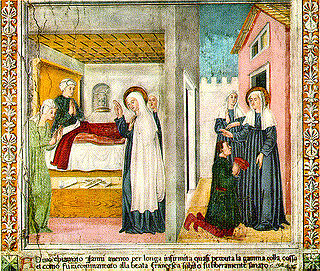
The Benedictines, officially the Order of Saint Benedict, are a mainly contemplative monastic order of the Catholic Church for men and for women who follow the Rule of Saint Benedict. Initiated in 529 they are the oldest of all the religious orders in the Latin Church. The male religious are also sometimes called the Black Monks, especially in English speaking countries, after the colour of their habits. Not all Benedictines wear black, however, with some like the Olivetans wearing white. They were founded by Benedict of Nursia, a 6th-century Italian monk who laid the foundations of Benedictine monasticism through the formulation of his Rule. Benedict's sister, Scholastica, possibly his twin, also became a religious from an early age, but chose to live as a hermit. They retained a close relationship until her death.

A nun is a woman who vows to dedicate her life to religious service and contemplation, typically living under vows of poverty, chastity, and obedience in the enclosure of a monastery or convent. The term is often used interchangeably with religious sisters who do take simple vows but live an active vocation of prayer and charitable work.
A religious order is a subgroup within a larger confessional community with a distinctive high-religiosity lifestyle and clear membership. Religious orders often trace their lineage from revered teachers, venerate their founders, and have a document describing their lifestyle called a rule of life. Such orders exist in many of the world's religions.

A monk is a man who is a member of a religious order and lives in a monastery. A monk usually lives his life in prayer and contemplation. The concept is ancient and can be seen in many religions and in philosophy.

Christian monasticism is a religious way of life of Christians who live ascetic and typically cloistered lives that are dedicated to Christian worship. It began to develop early in the history of the Christian Church, modeled upon scriptural examples and ideals, including those in the Old Testament. It has come to be regulated by religious rules and, in modern times, the Canon law of the respective Christian denominations that have forms of monastic living. Those living the monastic life are known by the generic terms monks (men) and nuns (women). The word monk originated from the Greek μοναχός, itself from μόνος meaning 'alone'.

Bernardo Tolomei was an Italian Catholic priest and the founder of the Congregation of the Blessed Virgin of Monte Oliveto. In the Roman Martyrology he is commemorated on August 20, but in the Benedictine calendar his optional memorial is celebrated on the previous day.

Francesca Bussa de' Leoni, known as Frances of Rome, was an Italian Catholic mystic, organizer of charitable services and a Benedictine oblate who founded a religious community of oblates, who share a common life without religious vows. She was canonized in 1608.

The Olivetans, formally known as the Order of Our Lady of Mount Olivet, are a monastic order. They were founded in 1313 and recognised in 1344. They use the Rule of Saint Benedict and are a member of the Benedictine Confederation, where they are also known as the Olivetan Congregation, but are distinguished from the Benedictines in their white habit and centralized organisation. They use the post-nominals 'OSB Oliv'.
In Christianity, an oblate is a person who is specifically dedicated to God and to God's service.

Gertrude the Great, OSB was a German Benedictine nun and mystic from the monastery of Helfta. She is recognized as a saint by the Catholic Church and figures in the General Roman Calendar on November 16 for optional celebration as a memorial throughout the Roman Rite.
The Benedictine Abbey of Regina Laudis was founded in 1947 by Mother Benedict Duss, O.S.B. and Mother Mary Aline Trilles de Warren, O.S.B. in Bethlehem, Connecticut. This monastic foundation was one of the first houses of contemplative Benedictine nuns in the United States. Mother Benedict and Mother Mary were both nuns of the Benedictine Abbey of Notre Dame de Jouarre in France. Mother Benedict had grown up in Paris and studied medicine at the Sorbonne. Until the monastery of Regina Laudis gained abbatial status, it was a dependent priory of Jouarre Abbey, a 7th-century monastery northeast of Paris, France.

There are a number of Benedictine Anglican religious orders, some of them using the name Order of St. Benedict (OSB). Just like their Roman Catholic counterparts, each abbey/priory/convent is independent of each other. The vows are not made to an order, but to a local incarnation of the order, hence each individual order is free to develop its own character and charism, yet each under a common rule of life after the precepts of St. Benedict. Most of the communities include a confraternity of oblates. The order consists of a number of independent communities.
The Community of the Holy Cross (CHC) is an Anglican religious order founded in 1857 by Elizabeth Neale, at the invitation of Father Charles Fuge Lowder, to work with the poor around St Peter's London Docks in Wapping. The Community moved to a large convent in Haywards Heath.

Chiara Offreduccio, known as Clare of Assisi, is an Italian saint who was one of the first followers of Francis of Assisi.
In the Catholic Church, a religious institute is "a society in which members, according to proper law, pronounce public vows, either perpetual or temporary which are to be renewed, however, when the period of time has elapsed, and lead a life of brothers or sisters in common."
The Subiaco Cassinese Congregation is an international union of Benedictine houses within the Benedictine Confederation. It developed from the Subiaco Congregation, which was formed in 1867 through the initiative of Dom Pietro Casaretto, O.S.B., as a reform of the way of life of monasteries of the Cassinese Congregation, formed in 1408, toward a stricter contemplative observance, and received final approval in 1872 by Pope Pius IX. After discussions between the two congregations at the start of the 21st century, approval was given by Pope Benedict XVI in 2013 for the incorporation of the Cassinese Congregation into its offshoot, the Subiaco Congregation. The expanded congregation was given this new name.

The Bernardine Cistercians of Esquermes are a small branch of the Cistercian Order. They follow the Rule of St Benedict, and co-operate with the apostolic mission of the Catholic Church through educational activities and hospitality. There are eight monasteries of nuns in six countries, united by a central Government.
The Colettine Poor Clares are a reform branch of the Order of St. Clare, founded by Clare of Assisi in Italy in 1211. They follow the interpretation of the Rule of St. Clare established in 1410 by Saint Colette, originally a French hermit and member of the Third Order of St. Francis.

St. Andrew Abbey-Cleveland is a Benedictine monastery in Cleveland, Ohio.

A religious sister in the Catholic Church is a woman who has taken public vows in a religious institute dedicated to apostolic works, as distinguished from a nun who lives a cloistered monastic life dedicated to prayer and labor, or a canoness regular, who provides a service to the world, either teaching or nursing, within the confines of the monastery. Nuns, religious sisters and canonesses all use the term "Sister" as a form of address.














